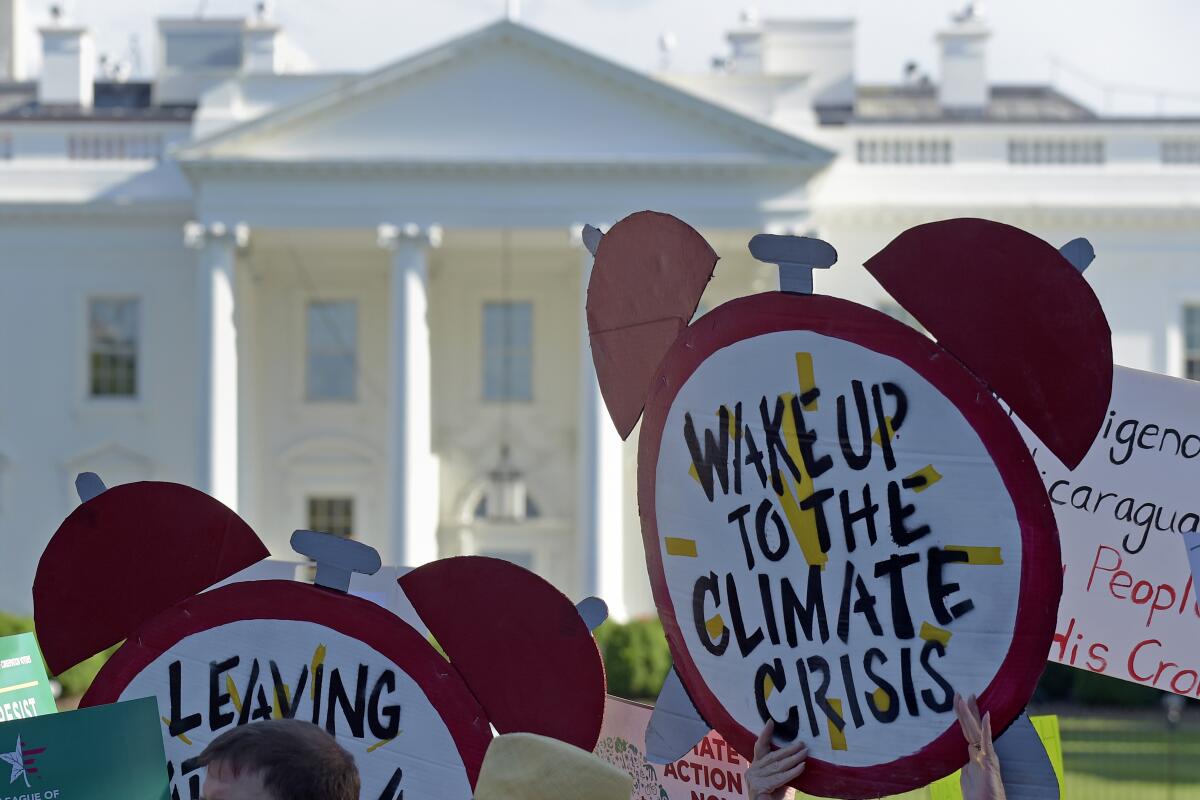At climate summit, Biden will try to reassure a skeptical world that the U.S. is back

- Share via
WASHINGTON — Mere hours after he was sworn in, President Biden signed an executive order committing the United States to rejoin the international accord designed to prevent the most catastrophic effects of climate change — the Paris climate agreement.
That was the easy part.
Now as the White House prepares to host virtual climate talks next week, world leaders, American lawmakers and environmental advocates are waiting to see just how ambitious Biden will be.
All eyes are focused on the new goal he sets for reducing greenhouse gas emissions by 2030 — a goal that may depend on a significant contribution from California — and which is a key step to reenter the agreement. Wherever he lands, this new pledge comes with a series of hard choices for the president and his advisors, who are constrained by Democrats’ slim majority in Congress, yet are determined to prove that fighting climate change is once again at the center of the nation’s international and domestic policy priorities.
The Trump administration’s decision to withdraw the U.S. from the Paris agreement and pursue a four-year campaign to weaken every major environmental law left the nation with a lot of catching up to do. Despite sharp drops in greenhouse gas emissions early in the pandemic, the U.S. is still far from reaching its Obama-era goal.
Biden will need to walk a careful line, policy experts said. The commitment he’s expected to announce in the run-up to the summit has to be aggressive enough to satisfy major environmental groups and progressive Democrats, surpassing the goal set by the Obama administration in 2015.
But it also has to be practical enough to persuade foreign leaders to take America at its word and strengthen their own climate-action commitments.
“I have no doubt the Biden administration wants to pursue the most ambitious 2030 target that it possibly can,” said Kelly Sims Gallagher, professor of energy and environmental policy at Tufts University’s Fletcher School. “I think the real question, and where the rubber meets the roads is: Is there a policy pathway for getting there?”
Biden’s infrastructure proposal includes a $174-billion investment in electric cars. But it doesn’t go as far as California’s plans.
Environmental groups and other climate advocates are pressuring the administration to promise an emissions reduction of at least 50% by 2030, compared to 2005 levels. Anything less, they say, and there would be little reason to hope for achieving the Paris agreement’s purpose of limiting warming to less than 2 degrees Celsius above preindustrial levels.
Scientists estimate that once temperatures exceed that threshold, the risks of more frequent natural disasters and food shortages exponentially increase. Coral reefs would mostly disappear, the Arctic could become ice-free in summer, and extreme heat waves would inflict suffering on nearly 40% of the world’s population.
Climate policy experts say they expect the Biden administration’s pledge, officially known as a nationally determined contribution, or NDC, to include the 50% reduction as part of a range of targets. That would far surpass President Obama’s target, which called for reducing emissions 26% to 28% below 2005 levels by 2025.
In an open letter to the White House, signed by more than 1,000 scientists, a 50% reduction was described as “both technically feasible and necessary.”
But whether it’s politically achievable remains an open question.
An analysis by the independent research firm Rhodium Group found that emissions fell last year to 21% below 2005 levels, largely because of the pandemic. Newer data show that as vaccines become more available and businesses reopen more fully, emissions are rising again.
Biden’s plans to reduce emissions hinge in large part on the fate of the $2.25-trillion infrastructure package he proposed last month. One of its most significant proposals to fight climate change calls for the creation of a national clean energy standard, which would require utility companies to get increasing amounts of energy from renewable sources like wind and solar and less from fossil fuels.
Republicans immediately panned the infrastructure proposal’s cost and the administration’s plans to pay for it with tax increases on corporate profits.
Though the prospect of bipartisan compromise looks slim, Nathaniel Keohane, a senior vice president at the Environmental Defense Fund, said Biden has to make sure his goals are aspirational, even if they face an uncertain political future on Capitol Hill.
“This ought to be a stretch target that motivates policy rather than one that follows policy,” he said. “Let’s not shy away from it. Lean into it. Put the pressure on Congress to act.”
While Biden attempts to get Republicans on board, senior Democrats in Congress are considering using a budget maneuver known as reconciliation that would enable them to bypass Republicans and push the bill through with 51 votes rather than the standard 60.
Pushing a large spending bill through the Senate on a party-line vote might work for some of Biden’s proposals to reduce emissions, such as plans to slash government subsidies to oil and gas companies and spend $174 billion to juice the nation’s electric vehicle market. But a Democratic congressional aide said lawmakers are still uncertain whether the fast-track reconciliation process, which is used to speed through changes to the federal budget, can be extended to include the clean energy standard.
“That’s the question people are asking and trying to answer right now,” the aide said. “If there’s a will there’s a way.”
With bipartisanship in short supply, the administration is expected to fill out its climate pledge with executive actions and regulatory changes that don’t require congressional approval. This could include new clean air protections, rules requiring oil and gas companies to quickly detect and repair methane leaks, and tougher fuel efficiency and emissions standards for cars and SUVs.
But these actions are likely to face legal challenges from the industries they’re designed to regulate, leaving their fate in the hands of federal judges — many of them appointed by President Trump.
The national pledge is also likely to count states and cities’ efforts to fight climate change toward its broader emissions goal of reducing emissions. At the forefront of that would be California’s climate policies, including its tougher car pollution regulations, which are followed by 13 other states, and Gov. Gavin Newsom’s order requiring all new cars sold to be zero-emission vehicles by 2035.
Some experts such as Robert Stavins, a professor of energy and economic development at Harvard University, said the U.S. has fallen so far behind in its emissions reductions that even if the Biden administration were able to combine and implement all these different measures, it would still be a stretch to achieve the 50% reduction without additional action by Congress.
“It’s not easy, but it’s conceivable,” Stavins said.
But activists and policy experts said the administration has little to gain by lowering its sights or waiting for Congress to act. A less ambitious climate pledge wouldn’t necessarily quiet criticism from the right, but it would anger the president’s political allies on the left.
More to Read
Get the L.A. Times Politics newsletter
Deeply reported insights into legislation, politics and policy from Sacramento, Washington and beyond. In your inbox three times per week.
You may occasionally receive promotional content from the Los Angeles Times.













